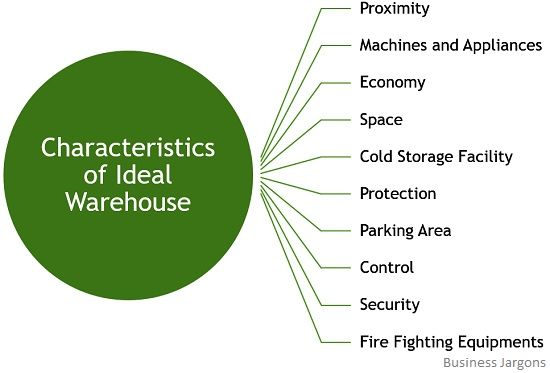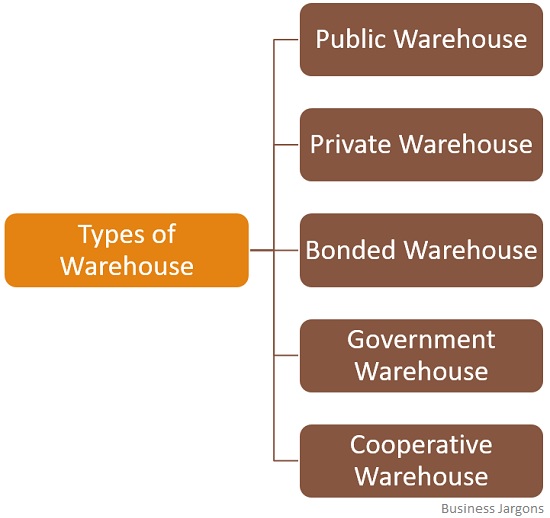Definition: Warehouse refers to the place where surplus goods are stored in a systematic manner so as to keep their quality, value and usefulness intact.
Warehouses facilitate in keeping a proper record of the items as to where they are stored, their time of arrival, until when the goods have been there and the quantity of stock in hand. It is the venture which is responsible for the safekeeping of the goods. The warehouse keeper is the person-incharge of the warehouse.
Characteristics of Ideal Warehouse
The characteristics of an ideal warehouse are:
- Proximity: A warehouse should be located at a place which is not far from the highway, railway station, airport, seaports, etc. so that the loading, unloading and transportation of the goods can be done easily at minimum possible cost and time. This means that it should be centrally located.
- Machines and Appliances: A warehouse must have mechanical appliances such as conveyors, computer-operated cranes, forklifts, etc. for loading and unloading goods conveniently. It helps in bringing down wastages during handling the goods, as well as reducing the handling cost.
- Economy: A warehouse should be economical. By economical we mean that the facilities provided by it must not be more than the cost involved in its construction and maintenance. The rentals should be reasonable.
- Space: There must be enough space within the warehouse building so as to keep the goods in a systematic manner. Besides this, proper containers, shelves and bins must be there to store the goods.
- Cold storage facility: There should be a cold storage facility in warehouses where perishable items such as vegetables, fruits, milk, eggs, butter and cheese, etc.
- Protection: Apart from the cold storage facility, warehouses should have the facility to protect the goods from external factors such as sunlight, wind, rain, rats, fire, dirt and dust, pests and insects, moisture, etc.
- Parking Area: There have to be proper space for parking of vehicles, i.e. trucks, lorries, etc, within the premises, which provides fast and smooth loading and unloading of goods.
- Control: There have to be arrangements for inspection, surveillance, physical verification and identification of goods. Moreover, goods must be handled with care and the staff should be trained and experienced in the concerned domain.
- Security: Theft of goods is one of the main concern of the businessmen. So, security systems like alarms, surveillance cameras, etc, should be there along with guards and watchman.
- Fire Fighting Equipment: Modern fire-fighting equipment must be installed in the premises and fire-proof arrangements must be there to prevent the loss caused due to fire outbreak and to store inflammable materials.
Types of Warehouses
There are five types of warehouses, discussed as under:
- Public Warehouses: Public Warehouses are the warehouses which an individual, port trust, government or wharfinger owns. Further, these are operated by Central Warehousing Corporation and State Warehousing Corporation. So, the storage facility is available on rent, i.e. for storing the goods, one has to pay the storage fee. The operation of these warehouses is governed by the government by issuing the license.
- Private Warehouses: Private Warehouses refers to the facility owned by the manufacturers, traders and merchants, for the preservation and storage of their own stock, such as raw materials or finished goods. These warehouses are located near the area of business, such as near the fields, business centres, or factories.
- Bonded Warehouses: Bonded Warehouses store imported goods, for which import duty is outstanding, i.e. not yet paid. These are licensed by the government to receive the imported goods on which tax and customs duty are due. Such warehouses are commonly owned by dock authorities and to get the imported goods, the importer has to pay the duty first.
- Government Warehouses: As the name suggests, the government (Central, state or Local Self Government) fully owns, and operates government warehouses. the management of the warehouses is looked after by the public sector undertakings.
- Cooperative Warehouses: These warehouses are owned, managed and operated by cooperative societies and the warehousing facilities are provided at reasonable prices, to the society members.
Nowadays, warehouses are equipped with modern and latest technology devices and appliances such as conveyors, forklifts and cranes, which has reduced manual labour to a large extent. And for warehouse management, logistics automation softwares are used.

Leave a Reply